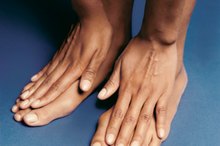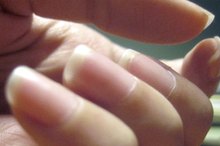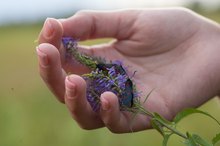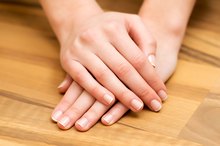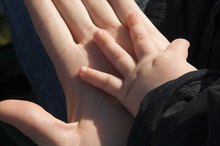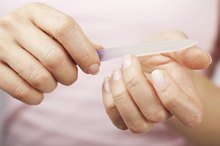Why Do My Fingernails Peel & Break?
Peeling and breaking of fingernails can be a frustrating problem, but it usually does not indicate that you have a significant medical condition. Nails that peel and break -- often called brittle nails -- are often part of the natural changes that occur with age 1. Frequent hand-washing or exposure to chemicals are other common reasons for brittle nails. Your doctor can help identify the cause and recommend the appropriate course of action.
Frequent Exposure to Water
Plunging your hands into water several times per day can actually dry out your fingernails. Fingernails swell when they are exposed to water and then later shrink as they become dry. Over time, repeated cycles of swelling and shrinking make it harder to hydrate the nails, and they begin to peel and break. If you wash dishes frequently, protect your hands with waterproof gloves. People who must frequently wash their hands on the job, such as restaurant staff or hairdressers, can apply a moisturizer at the base of the nails to improve hydration.
- Plunging your hands into water several times per day can actually dry out your fingernails.
- People who must frequently wash their hands on the job, such as restaurant staff or hairdressers, can apply a moisturizer at the base of the nails to improve hydration.
Exposure to Chemicals
What Are the Causes of Splitting and Peeling Nails?
Learn More
Harsh chemicals, including detergents or solvents, can damage your fingernails and make them brittle. If you work with chemicals at home or at work, wear gloves to help protect your nails. Ironically, some nail care products, such as nail polish or nail polish remover, can damage nails and make them brittle 1. Acrylic nails and tips are particularly likely to promote breaking and peeling. Using a moisturizer and avoiding exposure to chemicals can help restore your nail health.
- Harsh chemicals, including detergents or solvents, can damage your fingernails and make them brittle.
- If you work with chemicals at home or at work, wear gloves to help protect your nails.
Nail Trauma
Any type of injury to your nails can eventually lead to brittle nails 5. Typing, strumming a guitar or using your nails instead of a screwdriver or scraper are common culprits. Biting your nails or chewing on the cuticles can also damage your nails and promote dehydration. Try to avoid activities that injure your nails whenever possible. Soaking your hands in warm water for 15 to 20 minutes before bed may be beneficial.
- Any type of injury to your nails can eventually lead to brittle nails 5.
- Biting your nails or chewing on the cuticles can also damage your nails and promote dehydration.
Medical Conditions
What Causes Fingernails to Split & Dent?
Learn More
Peeling and breaking of the fingernails can be caused by a fungal infection of the nails. Less commonly, brittle nails are due to other nail or skin conditions, such as psoriasis. Sometimes, brittle nails are a sign of a general medical condition, such as thyroid disease or diabetes. If you consume a diet that is very low in protein or certain minerals or vitamins, you may have a deficiency of these substances, which can cause brittle fingernails. Adequate intake of the vitamin known as biotin is important for healthy nails. Ask your doctor if you think that you may have one of these medical conditions or if you are concerned that your diet may be inadequate.
- Peeling and breaking of the fingernails can be caused by a fungal infection of the nails.
- If you consume a diet that is very low in protein or certain minerals or vitamins, you may have a deficiency of these substances, which can cause brittle fingernails.
Related Articles
References
- The New Harvard Guide to Women's Health; Karen J. Carlson, Stephanie A. Eisenstat and Terra Diane Ziporyn
- Health Guidance: Peeling Nails? Reasons Why It's Happening
- CFP-MFC: Common Nail Changes and Disorders in Older People
- Dermatologic Therapy: Management of Simple Brittle Nails
- Singal A, Arora R. Nail as a window of systemic diseases. Indian Dermatol Online J. 2015;6(2):67-74. doi:10.4103/2229-5178.153002
- Yaemsiri S, Hou N, Slining MM, He K. Growth rate of human fingernails and toenails in healthy American young adults. J Eur Acad Dermatol Venereol. 2010;24(4):420-3. doi:10.1111/j.1468-3083.2009.03426.x
- Schons KR, Knob CF, Murussi N, Beber AA, Neumaier W, Monticielo OA. Nail psoriasis: a review of the literature. An Bras Dermatol. 2014;89(2):312-7. doi:10.1590/abd1806-4841.20142633
- Abdullah L, Abbas O. Common nail changes and disorders in older people: Diagnosis and management. Can Fam Physician. 2011;57(2):173-81.
- Sarkar M, Mahesh DM, Madabhavi I. Digital clubbing. Lung India. 2012;29(4):354-62. doi:10.4103/0970-2113.102824
- Haneke E. Controversies in the treatment of ingrown nails. Dermatol Res Pract. 2012;2012:783924. doi:10.1155/2012/783924
- Jefferson J, Rich P. Melanonychia. Dermatol Res Pract. 2012;2012:952186. doi:10.1155/2012/952186
- Aging Changes in Hair and Nails. Medline. National Institutes of Health Public Information Sheet.
- Nails and Nail Problems. American Academy of Dermatology Public Information Sheet.
Writer Bio
Marcy Brinkley has been writing professionally since 2007. Her work has appeared in "Chicken Soup for the Soul," "Texas Health Law Reporter" and the "State Bar of Texas Health Law Section Report." Her degrees include a Bachelor of Science in Nursing; a Master of Business Administration; and a Doctor of Jurisprudence.


